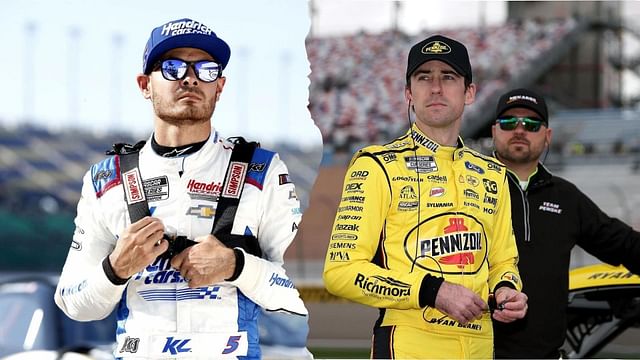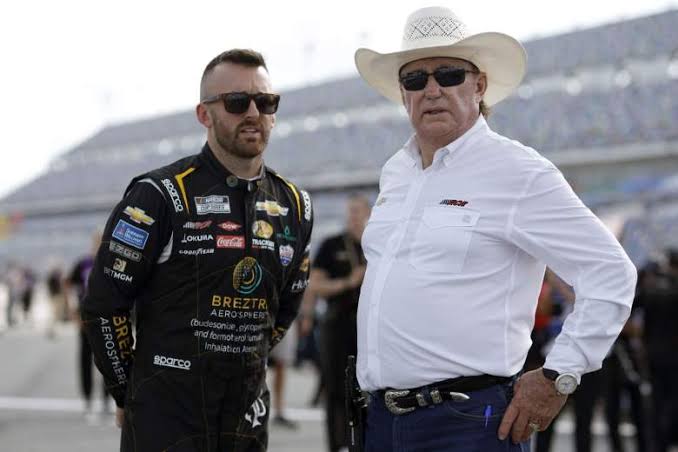NASCAR has issued a statement on the contentious restart involving Kyle Larson’s #5 Chevrolet and Ryan Blaney’s #12 Ford during the Brickyard 400 at Indianapolis Motor Speedway. Officials have declared that Larson’s first victory in this race was legitimate and that he did not jump the second-to-last restart.
The Brickyard 400 is one of NASCAR’s most anticipated events, featuring intense competition and strategic racing. For Kyle Larson, the race was a significant challenge, as he did not lead any laps until the final stages of the 167-lap race. The turning point came when Brad Keselowski ran out of fuel just before the first overtime restart on Lap 162. This incident allowed Larson to move up to the front row alongside Ryan Blaney.
In NASCAR, restarts are crucial and can determine the outcome of a race. The controversy during this restart arose when Ryan Blaney, the control car, was supposed to accelerate first. However, Kyle Larson appeared to accelerate slightly before Blaney, taking the lead into Turn 1 and sparking debate. Larson’s move led to a multi-car pileup, but he retained his lead for the final restart and went on to win the race.
NASCAR officials quickly addressed the controversy. Bob Pockrass, a noted NASCAR journalist, shared the official view on social media platform X (formerly Twitter). According to NASCAR, Ryan Blaney was the control car because he was the first car in the other lane when Brad Keselowski, the leader, ran out of gas. NASCAR concluded that Larson did not jump the restart.
Ryan Blaney, who finished third, expressed his frustration with the unexpected turn of events. Blaney was in a strong position to win, having registered his seventh top-five finish of the season. However, Keselowski’s fuel issue altered the race dynamics. Blaney criticized the decision by Keselowski’s team to stay out despite fuel concerns and was caught off guard when Larson took the front row spot.
The final caution of the race, triggered by Ryan Preece spinning out in Turn 2, added to the controversy. The caution was delayed until Preece’s car stalled on the track, by which time it was too late for any significant changes to the race order. This delay contributed to Blaney’s dissatisfaction, as it solidified Larson’s lead.
Kyle Larson’s victory at the Brickyard 400 was his third crown jewel race win, following victories at the Coca-Cola 600 in 2021 and the Southern 500. Despite the controversy, Larson’s win was a testament to his skill and ability to capitalize on unexpected opportunities.
The events at the Brickyard 400 highlight the complexities of NASCAR racing. The controversy over the restart underscores the importance of clear rules and consistent enforcement. NASCAR’s decision to uphold Larson’s victory despite the contentious restart reflects the nuanced nature of the sport.
The Brickyard 400 generated significant buzz among fans and media, with divided opinions on the restart controversy. Some fans supported Larson, while others sympathized with Blaney. Media coverage was extensive, with analysts dissecting every aspect of the restart and its impact on the race outcome.
Both Kyle Larson and Ryan Blaney are likely to learn from this experience. For Larson, the victory enhances his reputation as a top driver. For Blaney, the race serves as a reminder of the importance of adaptability and resilience.
The Brickyard 400 at Indianapolis Motor Speedway will be remembered for Kyle Larson’s dramatic victory and the surrounding controversy. NASCAR’s decision to uphold the win despite the contentious restart highlights the sport’s complexities. As the season progresses, the lessons from this race will influence future competitions. For NASCAR, maintaining transparency and consistency in rule enforcement is crucial for the sport’s integrity and excitement.



